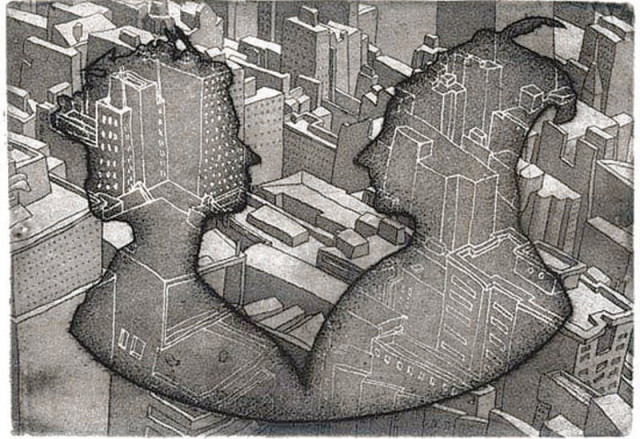Pakistan and Australia - an art alliance
A Pakistani and an Australian artist present collaborative etchings

A Pakistani and an Australian artist present collaborative etchings.
PHOTOS COURTESY GANDHARA GALLERY
After this successful show, the duo decided to work on their next collaboration. While the first show, ‘Hybrid I’ explored Pakistan, its counterpart, ‘Hybrid II’, currently exhibited at Gandhara Gallery, Karachi, has commonwealth as its theme and looks at the shared cultural heritage — colonial histories and the post-independence establishment of national identities and images — of Pakistan and Australia.

Chawk. PHOTOS COURTESY Gandhara Gallery

Putliwala. PHOTOS COURTESY Gandhara Gallery
Both Khan and Kowarsky live in countries far away from each other. Hence, the development of images was a back and forth process. Each month the artists exchanged images over email that were then transformed by the other to produce a true ‘hybrid’ of ideas. Interestingly, the only way cohesion could be maintained in this case was through adhering to pre-determined sizes for the work. Also, the back and forth negotiation led to the concepts developing and transforming along the way.
The technical printmaking process focuses on ink, paper and metal. Damon and Atif produced the etchings by hand using local and imported materials. Luckily, chemicals and presses were easily available at the National College of Arts Lahore (where they worked), chemicals and presses were easily available and Kowarsky also brought special papers and inks from his hometown to Lahore. In some stages of production, the artists took help from local technicians, but remained directly involved throughout.
The numerous prints by Khan and Kowarsky, displayed on both floors of the gallery are all monochromatic pieces; each 10x7 inches. Except for a few solo works by each artist, all prints were made in collaboration. A quick look at the pieces reveals images of urban landscapes of the two countries, coupled with images derived from Mughal miniature.

Rooh Khich . PHOTOS COURTESY Gandhara Gallery

Offerings . PHOTOS COURTESY Gandhara Gallery
Conversation displays an aerial view of a jumble of buildings, superimposed by silhouettes of a Mughal emperor and the queen. It delves into the subcontinent’s history of Mughal rule and colonial roots of both Pakistan and Australia. The silent ‘dialogue’ that takes place between the two figures seems to be one of mutual understanding. Balloon displays a huge balloon escaping a concrete jungle, leaving skyscrapers far behind they look miniscule. Perhaps this reflects the sentiments of every country’s working class struggling in an increasingly robotic world. With an interesting composition, this piece is one of the stronger ones. Chawk, referred to as ‘open square’ in English, is a print depicting an open courtyard/round-about. However, at first glance, while it looks familiar, it is difficult to determine whether this chawk is located in Pakistan or Australia. This is perhaps intentional to depict the similarity of certain urban spaces. In this piece, the techniques of etching and aquatint merge seamlessly.
On the other hand, Offerings displays a stark contrast in mark-making. The fine lines etched in the background, displaying men with grim faces, are beautifully offset by the slightly blurry, concentrated aquatint of two figures derived from Mughal miniatures. The dejected expressions of men sitting in the background are in contrast to those of their stoic counterparts in the foreground. The composition of Putliwala is also interesting, as it places a historical figure out of context and gives him a new role. In this case, Emperor Shah Jehan is seen as a puppet-maker in a deserted courtyard, in contrast to a typical grand depiction in a luxurious palace. Rooh Khich is a slightly foreboding, yet interesting piece. Superimposed over a jumble of buildings, cars and people (who seem to be in motion due to their linear etchings) is a photographer with Victorian-era equipment. While the cloth on the man’s face (reflective of photography at the time) makes him look ominous, his central placement on the print puts the viewer in the spot, almost making it appear like the viewer is being watched by the photographer and not the other way round. The title adds to this as its literal translation is ‘soul sucker’.

Conversation. PHOTOS COURTESY Gandhara Gallery
In their solo work, Khan’s pieces appear to be constructed through dotted marks, giving an overall slightly vague, surreal feel, such that they appear to be part of a dream. In contrast, Kowarsky’s forms are more clear-cut, neat and precise. However, it is this difference in their styles that both artists have managed to use to their advantage and create delightful narratives that are humorous, realistic and sometimes harsh. Nevertheless, they draw the viewer in and demand to be seen.
Shanzay Subzwari is an artist and art writer based in Karachi.
She tweets @ShanzaySubzwari
Published in The Express Tribune, Sunday Magazine, March 8th, 2015.



















COMMENTS
Comments are moderated and generally will be posted if they are on-topic and not abusive.
For more information, please see our Comments FAQ